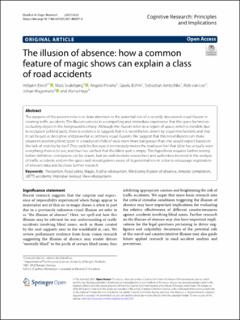| dc.contributor.author | Ekroll, Vebjørn | |
| dc.contributor.author | Svalebjørg, Mats | |
| dc.contributor.author | Pirrone, Angelo | |
| dc.contributor.author | Bøhm, Gisela Petra | |
| dc.contributor.author | Jentschke, Sebastian | |
| dc.contributor.author | van Lier, Rob | |
| dc.contributor.author | Wagemans, Johan | |
| dc.contributor.author | Høye, Alena | |
| dc.date.accessioned | 2022-02-11T14:46:16Z | |
| dc.date.available | 2022-02-11T14:46:16Z | |
| dc.date.created | 2021-03-25T11:17:18Z | |
| dc.date.issued | 2021-03-24 | |
| dc.identifier.citation | Cognitive Research: Principles and Implications. 2021, 6 (22), . | en_US |
| dc.identifier.uri | https://hdl.handle.net/11250/2978539 | |
| dc.description | Citation: Ekroll, V., Svalebjørg, M., Pirrone, A. et al. The illusion of absence: how a common feature of magic shows can explain a class of road accidents. Cogn. Research 6, 22 (2021). | en_US |
| dc.description.abstract | The purpose of the present note is to draw attention to the potential role of a recently discovered visual illusion in creating traffic accidents. The illusion consists in a compelling and immediate experience that the space behind an occluding object in the foreground is empty. Although the illusion refers to a region of space, which is invisible due to occlusion (a blind spot), there is evidence to suggest that it is nevertheless driven by visual mechanisms and that it can be just as deceptive and powerful as ordinary visual illusions. We suggest that this novel illusion can make situations involving blind spots in a road user's field of view even more dangerous than one would expect based on the lack of visibility by itself. This could be because it erroneously makes the road user feel that (s)he has actually seen everything there is to see, and thus has verified that the blind spot is empty. This hypothesis requires further testing before definitive conclusions can be drawn, but we wish to make researchers and authorities involved in the analysis of traffic accidents and on-the-spot crash investigations aware of its potential role in order to encourage registration of relevant data and facilitate further research. | en_US |
| dc.language.iso | eng | en_US |
| dc.publisher | Springer Nature | en_US |
| dc.title | The illusion of absence: how a common feature of magic shows can explain a class of road accidents | en_US |
| dc.type | Journal article | en_US |
| dc.type | Peer reviewed | en_US |
| dc.rights.holder | Copyright © 2021, The Author(s) | en_US |
| dc.description.version | publishedVersion | en_US |
| cristin.ispublished | true | |
| cristin.fulltext | original | |
| cristin.fulltext | postprint | |
| cristin.qualitycode | 1 | |
| dc.identifier.doi | 10.1186/s41235-021-00287-0 | |
| dc.identifier.cristin | 1900973 | |
| dc.source.journal | Cognitive Research: Principles and Implications | en_US |
| dc.source.volume | 6 | en_US |
| dc.source.issue | 22 | en_US |
| dc.source.pagenumber | 16 | en_US |
